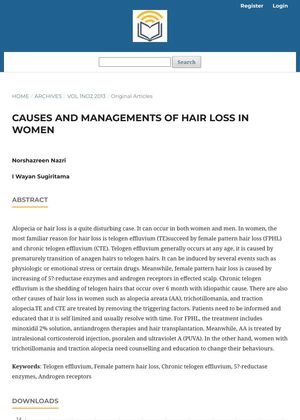Causes and Management of Hair Loss in Women
January 2013
telogen effluvium female pattern hair loss chronic telogen effluvium anagen hairs telogen hairs 5?-reductase enzymes androgen receptors alopecia areata trichotillomania traction alopecia minoxidil antiandrogen therapies hair transplantation intralesional corticosteroid injection psoralen ultraviolet A TE FPHL CTE AA Rogaine UV-A

TLDR The document concludes that hair loss in women can be caused by various factors and is managed with specific treatments like medication, therapy, and lifestyle changes.
The document from 2012 discussed the causes and management of hair loss in women, specifically focusing on telogen effluvium (TE), female pattern hair loss (FPHL), and chronic telogen effluvium (CTE). TE, which can occur at any age, is caused by the premature transition of anagen hairs to telogen hairs, often triggered by stress or certain drugs. FPHL is caused by an increase in 5?-reductase enzymes and androgen receptors in the affected scalp. CTE is characterized by the shedding of telogen hairs over a period of 6 months with an unknown cause. Other causes of hair loss in women include alopecia areata (AA), trichotillomania, and traction alopecia. Treatments for these conditions vary: TE and CTE are managed by removing triggering factors, FPHL is treated with minoxidil 2% solution, antiandrogen therapies, and hair transplantation, and AA is treated with intralesional corticosteroid injection, psoralen, and ultraviolet A. Women with trichotillomania and traction alopecia require counseling and education to change their behaviors.





